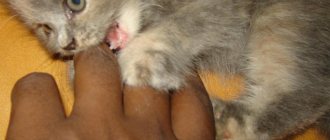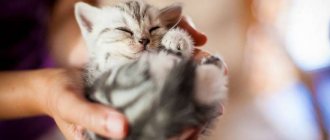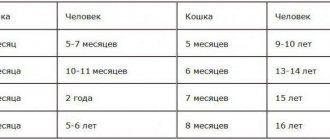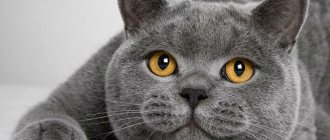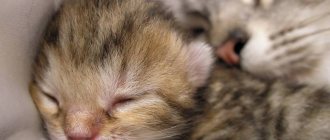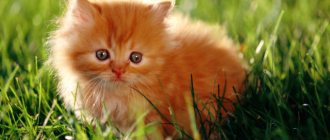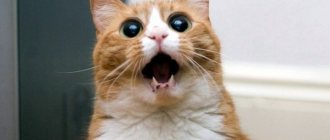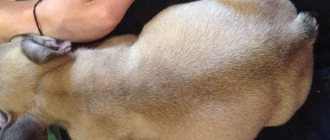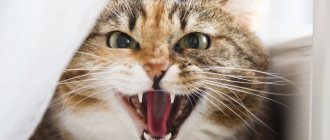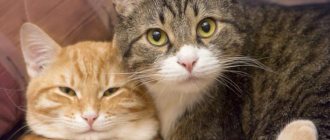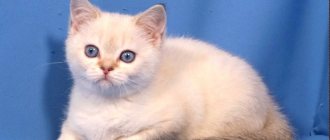Looking at a small pet, many owners wonder: to what age do cats grow when their tiny lump turns into a big handsome one. The growth of a cat directly depends on many factors:
- from the breed of the animal;
- on the size of the pet’s parents (heredity);
- from feeding;
- from past diseases.
Important! On average, cats grow up to 14-15 months, but in some animals growth ends a little earlier.
Growth and development of kittens
Kittens of different breeds are born with different weights - from 60 g to 200. This also depends on how many kittens were in the litter: the fewer, the larger the babies will be.
Felinologists distinguish several stages of development and growth of kittens:
- neonatal (1-4 days after birth);
- suckling (1 month);
- transitional (from 1 month to 2);
- post-suction (from 2 months to six months).
At each stage, the baby’s nutrition is decisive. It is up to six months that the formation of the skeleton and the main development of the kitten occurs, so make sure that the diet is balanced and varied. Be sure to give your baby vitamins.
Important! The nutrition of a kitten for up to six months lays the foundation for its development and growth, so be sure to take into account the advice of experts: it is dangerous to both underfeed and overfeed kittens.
Past illnesses will also have a negative impact on the baby’s growth. Therefore, regularly show the kitten to the veterinarian.
Stages of growth
How to bathe a kitten: with what frequency and at what age
There are several phases of growth in pets. The active growth phase usually lasts until the end of maturation, approximately 10-15 months (depending on the breed). Large breeds (for example, Maine Coons, Bengals, Servals) grow up to 2 years, and smaller ones - up to 3 years.
Important! At each stage of growth, the cat must be provided with favorable development conditions by the owner so that there are no developmental delays or deviations.
From birth to 4 days
This is the very first period from the moment the animal is born to 4 days. The period is called neonatal. The period is characterized by weight loss in babies.
Second period
The period is called suction. It lasts 3-3.5 weeks. The main trends of this stage: weight gain, active growth.
Transition stage
A longer period of 4 to 6 weeks. The main trends of the stage: active growth of all organs.
Post-suction stage
The teenage period is calculated from 2 months until the end of the cat’s development, which depends on the breed. The peak period coincides with the age of 3-5 months. When the teenage stage ends, cats stop growing, and cats increase by a maximum of 2-3 cm.
Important! By the age of 1 year, cats grow in length and breadth. After a year, they only grow in width until they gain the weight characteristic of their breed.
Dependence of cat growth on breed
The size of the animal, and accordingly how long it will grow, depends on the breed. Breed characteristics usually indicate how long cats grow. Ordinary (yard) ones, as a rule, are formed by the year.
If the seals are miniature breeds (for example, Munchkin, Singaporean), they reach their maximum size slightly earlier, at approximately 9 months - one year. These animals, by their nature, cannot be large in size, so they can reach their maximum size quite quickly.
Important! According to breed standards, among miniature cats, those individuals that are the smallest in size are especially valued.
Medium-sized animals (British, Scottish) have approximately the same growth rates. Thus, felinologists, explaining to what age British cats grow, indicate that by 10 months to a year these pets reach maturity, while their physical development can last up to two years. It is at this age that animals become especially beautiful. But to what age Scottish Straight cats grow is determined by the characteristics of their breed. They usually reach their maximum size by 2 - 2.5 years. Cats of this breed grow a little faster, by 1.5-2 years, despite the fact that they become sexually mature earlier. These criteria determine the age at which Scottish Fold cats grow.
But representatives of large breeds can sometimes increase in size up to three years. May-Coon, Chausie, and Bengal kittens are born quite large. Up to a year, these animals are at the stage of active growth, after which they gain muscle mass and grow, but not at such a fast pace.
How old do exotic cats grow?
The development of exotics at the physiological level occurs a little slower. They enter puberty later than other cats, their immunity is formed more slowly and their bones take longer to strengthen. This is why cats of this breed are more susceptible to fractures and infections than others. At two and a half to three years, everything returns to normal, the bones become strong enough, and the formed immunity is able to resist viruses and infections.
The slightly delayed development of this breed is not considered a pathology or abnormality. This is due to the level of metabolic processes in the body and their speed. Morphological development ends by two years, just like in all other cats.
- Related Posts
- Find out how many years do domestic British cats live?
- Find out how long Scottish Fold cats live?
- Find out how long hairless Sphynx cats live?
- Find out how long Persian cats live at home
- Find out how long Thai cats live?
- Find out how long do Siamese cats live?
How does feeding affect the growth of cats?
Inadequate nutrition, as well as excess, can affect the growth and development of a pet, so caring owners must take into account feeding recommendations:
- It is better to eat food in the morning and evening, dividing the daily intake equally (or making the morning intake larger);
- do not allow the cat to finish eating after other pets;
- do not feed the animal from your table: your food does not always suit them;
- If your pet eats natural food that you prepare yourself, keep in mind that not all foods are healthy for cats.
- Periodically add vitamins to your pet's food.
Important! If you see deviations from the average norms of development and growth of your cat, be sure to consult a specialist who, if there are no other reasons, will help adjust the diet.
What reduces growth rates
If a kitten lags behind in growth from its brothers and sisters, as well as from the growth and development norms characteristic of its breed as a whole, the factors causing the slowdown in this indicator should be identified and eliminated:
- insufficiency or imbalance of the diet - it is worth reviewing the kitten’s diet to determine whether it contains enough essential nutrients, vitamins and minerals, and also get advice from a veterinarian on optimizing the animal’s nutrition;
- unfavorable living conditions - kittens living in unsuitable conditions (for example, on the street) lag behind in growth compared to domestic and well-groomed pets, so often a baby picked up on the street turns out to be older than the age at which he initially looked;
- early sterilization in cats, which is recommended before the first heat, and especially early castration in cats (in this case, the pet is indicated for hormone replacement therapy to eliminate growth retardation);
- helminthic infestations - with a massive infection, a kitten’s growth can slow down significantly, even completely stopping, since helminths deprive the baby of adequate nutrition, and also cause intoxication and weakened immunity (therefore, growing kittens are regularly given anthelmintics, once a quarter);
- any diseases suffered by a kitten can negatively affect its growth rate, therefore special attention is paid to: vaccination;
- preventive veterinary examinations;
- weighing and measuring the baby;
- maintaining records reflecting the data of its development;
Reasons that inhibit the growth of cats
Animals of the same breed and even those produced by the same parents are not always the same size. There are several reasons that affect growth:
- diet: the foods or feeds you give your pet can stimulate growth or slow it down; abnormal nutrition will certainly affect the size of the animal;
- the presence of parasites in a cat’s body: sometimes it can be difficult to determine, but it is all kinds of worms inside your pet that take away the vitamins and microelements necessary for growth and development;
Important! Veterinarians recommend giving cats anthelmintic drugs twice a year, even if there is no obvious presence of parasites.
- hormonal imbalances: pets, like people, are susceptible to hormonal imbalances; If you observe a sharp jump in growth or, conversely, a slowdown, contact a veterinarian and undergo the necessary examination with the animal.
Important! Sterilizing an animal can affect its growth, so doctors do not recommend this procedure for adult animals: they can suddenly gain excess weight, which will affect their well-being.
Factors influencing growth
Prosperous adulthood depends on genetic predisposition and the environment. A person cannot influence genetics, but he can create conditions for harmonious development.
Hereditary
This group includes the following points:
- Breed. Representatives of large varieties grow more slowly and longer. Maine Coons, British, and Bengals finish their development by the age of 2–3 years. Miniature individuals - Singaporeans, munchkins and others - reach their maximum size by one year, their medium-sized counterparts - by 14-18 months.
- Floor. In the first 6–12 weeks, kittens develop equally; after this period, males gain weight faster, and their growth ends later. Cats reach maturity and take on a complete appearance earlier, and when they mature, they look smaller than males.
- Parents' size. Kittens rarely outgrow their mother and father: the smaller they are, the smaller the cubs, and vice versa. The final physical indicators are determined by the stronger genotype.
- Individual genetics . When breeds are mixed, individuals are born with their own hereditary program. This explains the difference in the rate of increase in skeleton and muscles in kittens of the same litter.
To control the maturation of a pet, it is useful for the owner to see its parents and inquire about the characteristics of the breed.
External
The well-being of maturation depends on the habitat and proper care, this can be seen when comparing street and domestic cats.
In addition to genetic factors, the pace of maturation is determined by the following factors:
- Conditions of detention. A cat develops normally in a microclimate suitable for it, at an air temperature of 20–22 ℃ and a humidity level of 50–60%. At low temperatures, blood circulation is impaired, which negatively affects cartilage tissue and bone formation.
- Diet. A balanced diet enriched with vitamins and microelements is a decisive factor in the successful growth of cats. For the first month and a half, they are still able to do without human help, because they eat cat milk. From the 7th week, feeding becomes the responsibility of the owner. Poor nutrition in the first year of existence leads to pathologies in the formation of the skeleton and a lack of muscle mass.
- Lifestyle. Active pets grow faster than their passive counterparts.
- Sleeping mode. Kittens sleep up to 18–20 hours a day; regular violations of this routine lead to a malfunction of the central nervous system.
With early castration or sterilization, up to 5 months, the skeleton grows longer, and the growth zones close later. Upon reaching maturity, cats look larger than their uncastrated counterparts.
Record-breaking animals
The largest cat whose result is recorded in the Guinness Book of Records is the Maine Coon Sweetie from the USA. At 5 years old, he had a length of 123 cm and a tail of 41.5 cm (by the way, Sweetie is also the owner of the longest tail among the representatives of his breed). The cat’s owners said that they didn’t feed their pet anything special, and his growth happened on its own.
Fiz Gel from the USA (Munchkin breed) is recognized as the smallest cat. Her height is only 15 cm. Despite her modest size, she is very mobile: she can easily jump on even the tallest objects.
The Persian Tinker Toy is considered the smallest cat. Its height is only 7 cm and its length is 19 cm. This growth of an adult animal is explained by genetic mutations. But this did not stop the animal from taking its place among the record holders in the book of records.
